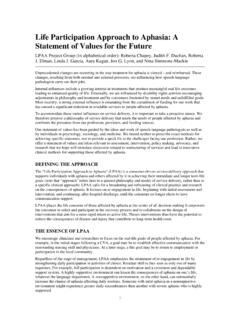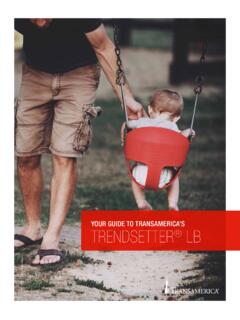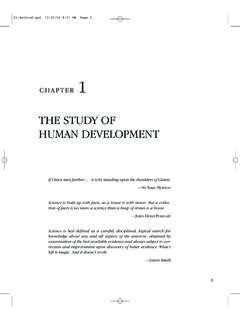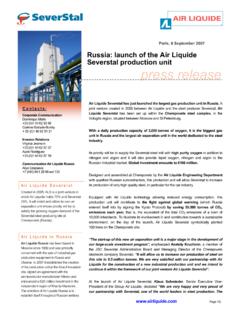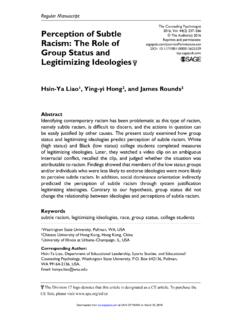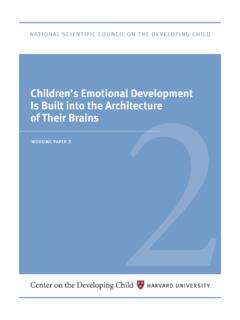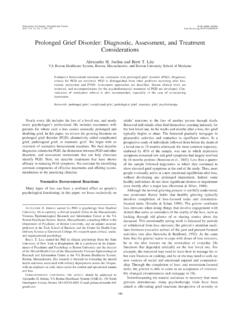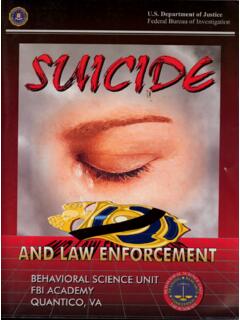Transcription of A-FROM in Action at the Aphasia Institute
1 A-FROM in Action at the Aphasia InstituteAura Kagan, centers are in an excellent position to contribute to thebroad definition of health by the World Health Organization: theability to live life to its full potential. An expansion of this definition bythe World Health Organization International Classification of Func-tioning, Disability and Health (ICF) forms the basis for a user-friendlyand ICF-compatible framework for planning interventions that ensuremaximum real-life outcome and impact for people with Aphasia andtheir families. This article describes Living with Aphasia : Frameworkfor Outcome Measurement and its practical application to aphasiacenters in the areas of direct service, outcome measurement, andadvocacy and awareness. Examples will be drawn from the AphasiaInstitute in Toronto.
2 A case will be made for all Aphasia centers to usethe ICF or an adaptation of it to further the work of this sector andstrengthen its : Aphasia , Aphasia centers, ICF, A-FROM , interventionLearning Outcomes:As a result of this activity, the reader will be able to (1) situate the work of Aphasia centerswithin an outcome-driven framework for intervention that is grounded in the World Health Organization sInternational Classification of Functioning, Disability and Health; (2) use key Living with Aphasia : Frameworkfor Outcome Measurement ( A-FROM ) principles to broaden thinking about intervention and outcome; and (3)adapt illustrative A-FROM examples to his or her own Aphasia Institute in Toronto, Can-ada began in Pat Arato s basement in to accept the hopeless scenariopainted by medical specialists who told herthat her husband Oscar would not make anymore improvement, Pat gathered a few familiesand volunteers together to try and turnhopelessintohope.
3 The current multiplicity of aphasiacenters across North America and internation-ally, many directly or indirectly influenced byPat s vision, is testament to what she hasachieved. Many of these centers have beenstarted by speech-language pathologists and/orfamily members determined to ensure ongoing1 Education and Applied Research, Aphasia Institute ,Toronto, for correspondence and reprint requests: AuraKagan, , 73 Scarsdale Road, Toronto, ON M3B2R2, Canada (e-mail: Centers: A Growing Trend in NorthAmerica; Guest Editor, Nina Simmons-Mackie, ,BC-ANCDSS emin Speech Lang 2011;32:216 228. Copyright#2011 by Thieme Medical Publishers, Inc., 333 SeventhAvenue, New York, NY 10001, USA. Tel: +1(212) : by: Thieme Verlagsgruppe. Copyrighted and growth opportunities for individu-als with Aphasia .)
4 Like the Aphasia Institute ,many have been founded at a grassroots levelwith minimal funding and resources. In othercases, administrators have had to be persuadedto allow an Aphasia group to be offered as aservice. Pat s ideas are captured in the currentvision of the Aphasia Institute no barriers toliving successfully with Aphasia . Although thevision of no barriers seems distant, those of uswho work in Aphasia centers know, based onextensive firsthand experience, that individualsand families living with Aphasia can regain ameaningful quality of life (QOL) with appro-priate intervention, despite the fact that lan-guage impairment has not been cured. Currently, the Aphasia Institute is ateaching and learning center that operates asa synergy of direct service, education andtraining, and research and development.
5 Inaddition to acting as an information resource,in any given year we provide direct service toover 200 people with Aphasia and familymembers within the Greater Toronto range of direct services is offered includingprofessionally supervised volunteer-led con-versation groups, a professionally led intro-ductory program that includes a parallelcurriculum for families, exercise, various rec-reational and educational activities of choice,and a variety of education, training, and re-search our programs have evolved over thepast three decades, we have struggled with asimple method of communicating what wedo to potential clients, funders, administra-tors, and even prospective staff solution has been the adoption of abroad, common, nonprescriptive outcomeframework relevant to the real-life impactof Aphasia and grounded in the InternationalClassification of Functioning, Disability andHealth (ICF).
6 1 The current article describeshow this simple framework can potentiallyfurther the work of individual Aphasia centersand the Aphasia center sector as a discussed will include directservice, outcome measurement and evidence,and finally awareness and advocacy, withillustrative examples drawn from the TO LIVING WITHAPHASIA: FRAMEWORK FOROUTCOME MEASUREMENTA phasia centers offer a diverse array of pro-grams but have a common underlying beliefsystem regarding the potential for learning tolive successfully with Aphasia . Expert opinion aswell as an emerging research literature suggestthat this potential is reached by offering inter-ventions that may include, but go beyond,addressing the language impairment itself interventions that target life with ,3 Because of the nontraditional and innovativenature of this intervention, administrators, pol-icy makers and funders are often unfamiliarwith potential benefits and unclear about therationale for our services.
7 Therefore, to advo-cate for our sector or our own individualagencies, it is helpful to be able to articulatewhat we do and the results we achieve in a waythat is clearly understandable and has credibil-ity with decision makers. Providing a solidconceptual base for our work will help tostrengthen our case for support and help planintervention in a way that ensures outcomeswith real-life impact for individuals and fami-lies living with Aphasia . Living with Aphasia :Framework for Outcome Measurement ( A-FROM ) was developed with this in mind. A-FROM is a user-friendly version of the ICFthat has been adapted for Aphasia and beenpreviously line with the values ofthe Life Participation Approach to Aphasia ,5A-FROM captures the domains of interven-tion and outcome that are relevant for aphasiacenters and is presented in an accessible andexplicit format that allows for easy practicalapplication.
8 A-FROM makes anexplicitstate-ment about the contribution of four domains toQOL with Aphasia (see Fig. 1 and Table 1).The use of overlapping circles rather thanseparate boxes with arrows is deliberate andsuggests the real-life overlap and interactionbetween the four domains and overall QOLwith not prescriptive in relation tospecific interventions or outcome measurementmethods/tools, A-FROM does emphasize theimportance of focusing on outcomes relevant toliving with Aphasia . It provides clinicians, cli-ents, funders, and other stakeholders with aA-FROM IN Action AT THE Aphasia Institute /KAGAN217 Downloaded by: Thieme Verlagsgruppe. Copyrighted 1 Living with Aphasia : A Framework for Outcome Measurement ( A-FROM ). (Reprinted withpermission from Taylor & Francis Ltd. Kagan A, Simmons-Mackie N, Rowland A, Huijbregts M, ShumwayE, McEwen S, Threats T, Sharp S.)
9 Counting what counts: a framework for capturing real-life outcomes ofaphasia intervention. Aphasiology 2007;22:258 )Table 1 Description of A-FROM DomainsDomainDescriptionLanguage and related impairmentsEquivalent to impairment in the ICF and includes traditionalareas such as talking, understanding, reading, and writingEnvironmentAnything outside of the person that facilitates and/or acts as abarrier to communication including individual/societal attitudes,partner attributes, physical factors, and language barriersParticipationActual involvement in relationships, roles, and activities ofchoice situations that form part of daily lifePersonal factorsInherent characteristics of the person, feelings, emotions,attitudes, and identity or sense of selfA-FROM, Living with Aphasia : Framework for Outcome Measurement.
10 ICF, World Health Organization InternationalClassification of Functioning, Disability and IN SPEECH AND LANGUAGE/VOLUME 32, NUMBER 3 2011 Downloaded by: Thieme Verlagsgruppe. Copyrighted for thinking about the outcomes ofvarious interventions. Without defining suc-cess in terms of meaningful outcomes, thedefinition of a successful intervention outcomecan be too narrow. For example, the speech-language pathologist might work on the do-main of language impairment using a neuro-linguistic treatment for writing; however, themeaningful outcome is actually change in howwriting is used in daily life (participationdomain) as well as related changes in areassuch as motivation, sense of autonomy, andconfidence (personal domain). In other words,the most critical outcomes are those of partic-ipation (relationships, roles, and activities ofchoice) and personal factors (feelings, atti-tudes, identity).
